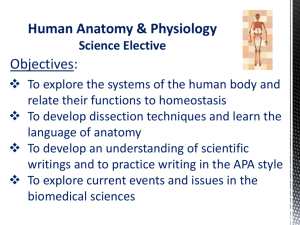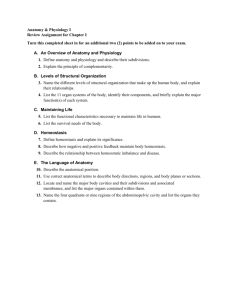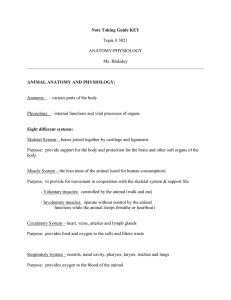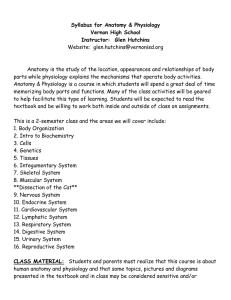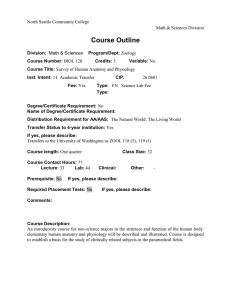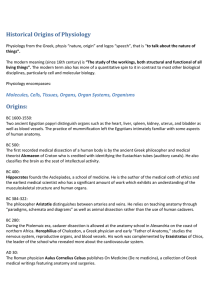Honors Anatomy & Physiology Syllabus - High School Course
advertisement
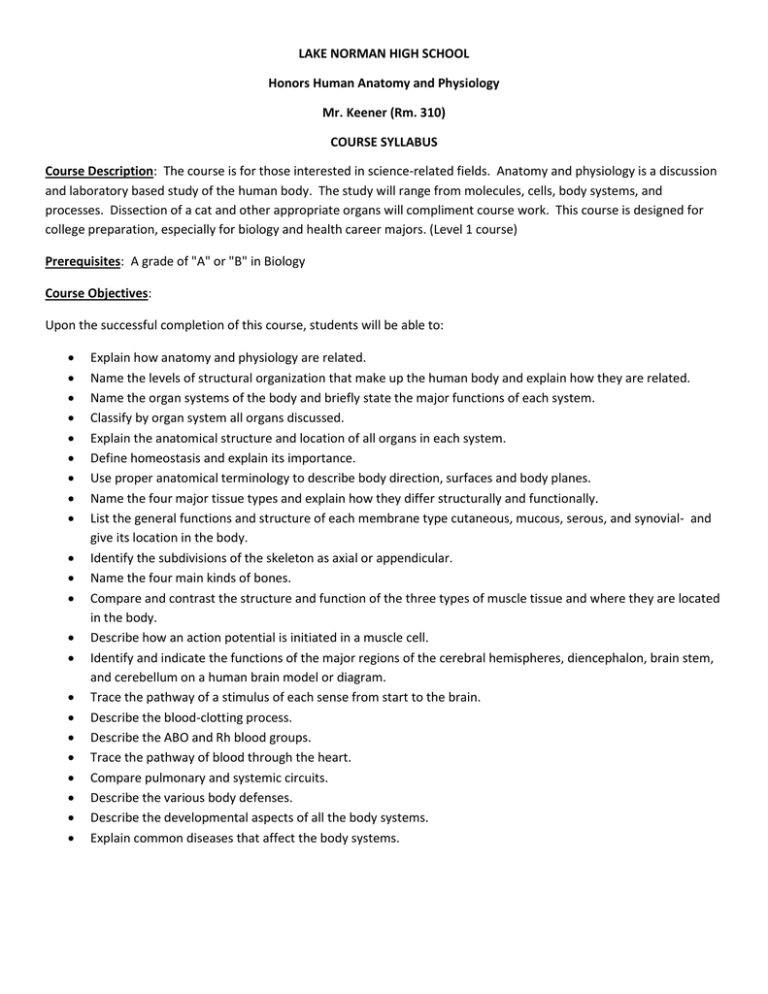
LAKE NORMAN HIGH SCHOOL Honors Human Anatomy and Physiology Mr. Keener (Rm. 310) COURSE SYLLABUS Course Description: The course is for those interested in science-related fields. Anatomy and physiology is a discussion and laboratory based study of the human body. The study will range from molecules, cells, body systems, and processes. Dissection of a cat and other appropriate organs will compliment course work. This course is designed for college preparation, especially for biology and health career majors. (Level 1 course) Prerequisites: A grade of "A" or "B" in Biology Course Objectives: Upon the successful completion of this course, students will be able to: Explain how anatomy and physiology are related. Name the levels of structural organization that make up the human body and explain how they are related. Name the organ systems of the body and briefly state the major functions of each system. Classify by organ system all organs discussed. Explain the anatomical structure and location of all organs in each system. Define homeostasis and explain its importance. Use proper anatomical terminology to describe body direction, surfaces and body planes. Name the four major tissue types and explain how they differ structurally and functionally. List the general functions and structure of each membrane type cutaneous, mucous, serous, and synovial- and give its location in the body. Identify the subdivisions of the skeleton as axial or appendicular. Name the four main kinds of bones. Compare and contrast the structure and function of the three types of muscle tissue and where they are located in the body. Describe how an action potential is initiated in a muscle cell. Identify and indicate the functions of the major regions of the cerebral hemispheres, diencephalon, brain stem, and cerebellum on a human brain model or diagram. Trace the pathway of a stimulus of each sense from start to the brain. Describe the blood-clotting process. Describe the ABO and Rh blood groups. Trace the pathway of blood through the heart. Compare pulmonary and systemic circuits. Describe the various body defenses. Describe the developmental aspects of all the body systems. Explain common diseases that affect the body systems. Required Class Materials: Three ring binder (at least 1") Colored Pencils Internet Access Text: The Essentials of Human Anatomy and Physiology 7th Ed., Marieb The Anatomy Coloring Book, Kapit/Elson Course Outline: Chapter 1: The Human Body: An Orientation Chapter 16: The Endocrine System Chapter 2: Basic Chemistry Chapter 17: Blood Chapter 3: Cells Chapter 18/19: The Cardiovascular Sys. Chapter 4: Tissues Chapter 20/21: The Lymphatic/Immune Chapter 5: Skin and Body Membranes Chapter 22: The Respiratory System Chapter 6/7/8: The Skeletal System Chapter 23: The Digestive System Chapter 9/10: The Muscular System Chapter 25: The Urinary System Chapter 11/12/13/14: The Nervous System Chapter 27: The Reproductive Sys. Chapter 15: Special Senses Major Assignments: Tests and Quizzes on each of the chapters listed above Binder Checks (x2) Disease/career paper Lab Reports-throughout the year as labs are completed Dissection of Cat *This list is tentative and is subject to change. Class Policies & Procedures: All work is due at the beginning of the class period or when specified by the teacher. IF it is not turned in at that time it is considered late and will follow the late policy. LATE POLICY: You have until 8:15 am of the following calendar day to turn it in for a grade no higher than 75% of the available points or a D+. After 8:15 am it will no longer be accepted for credit and you will be given a zero. Late assignments can be turned it to me directly or to my mailbox in the office. As for excused absences. You have the same amount of days ( not class periods) to make up homework that you missed. So if you are gone one day, you have one day to make it up. If not made up or scheduled the make up in the allotted time it is late and will follow the previously mentioned late policy. This goes for tests, quizzes, labs, homework, etc. Whatever is not made up in the proper amount of time will become zeros. Since we are on the 8-block schedule it is YOUR RESPONSITBILITY to come and get your assignment THE DAY YOU GET BACK AND NOT THE NEXT DAY YOU HAVE MY CLASS! If your work does not have your name on it and/or is illegible it is hard to grade and record a grade. This may result in a zero. Be in your seat, quiet and working when the bell rings. If not in your seat when bell rings it will be considered a tardy. Be prepared for class every day. Be respectful to teacher, classmates, and equipment. Use classroom equipment and materials for intended purposes only. Consequences: 1st infraction will receive a warning and a conference with the teacher, second infraction will entail a contact with the parent and a classroom detention, Subsequent infractions will involve further action. Cheating in ANY form will not be tolerated. Action will be taken according to the handbook. Miscellaneous: The amount of homework will vary from week to week and many times will depend on how well you use available class time!!!!! As a rule, expect homework every night. Homework, labs, etc will be collected on a regular basis and graded. Binders will be collected twice a semester. Things to know in order to succeed: Keep up with homework, be involved in discussion and activities, take notes and review them often and ask questions and/or for help when needed. Contact Information I usually get to school around 7:30 AM. I coach football in the fall and track in the spring, so I am at school fairly late most days. Please call the school and leave a message on my voicemail and I will try to get back to you as soon as possible. I have 4th block planning (1:19-2:43)… this would be the best time to get a hold of me during the day. You can also visit my school website for other information. Phone: 704-799-8555 Email: jkeener@iss.k12.nc.us



